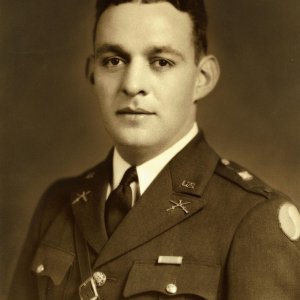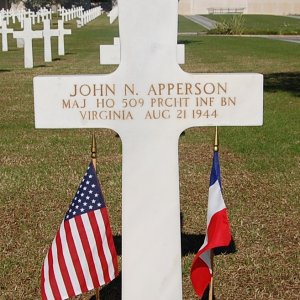- SURNAME
Apperson
- FORENAME
John Newton
- UNIT
509 Parachute Infantry Battalion (HQ and HQ Company - Bn XO)
- RANK
Major
- NUMBER
0-301346
- DATE OF DEATH
21st August 1944
- AGE
37
- GRAVESITE
Rhone American Cemetery, Draguignan, France Plot A Row 10 Grave 1
- ADDITIONAL INFORMATION
from Henrico County, Virginia
born 21.11.1906, New Kent County, Virginia, USA
father William Armstead Apperson (1882-1964)
mother Ellen Douglas (nee Harris) Apperson (1883-1951)
attended John Marshall High School (3 years)
civil occupation seed analyst (Virginia Department of Agriculture)
1928 married Katherine Ann (nee Lawrence)
daughters Katharine Apperson Emerson (1933-2009)
KIA South France
Before the War
John Newton Apperson was born on November 21, 1906, in New Kent County, Virginia, a farming community just outside the city of Richmond. Apperson and his sister, Elizabeth, were raised by their mother and her extended family. Throughout his life, Apperson was very close to his uncle Major Herbert Witt Harris, who helped to raise him and later encouraged Apperson’s military service.
As a child, Apperson showed signs of being a talented artist. In 1914, at age 8, he entered an art contest in the Richmond Times Dispatch and received an honorable mention for his drawing, A Solider at War. Apperson also played basketball, baseball, and football in high school. His hobbies included fishing and hunting, and he later achieved the designation of sharpshooter in the U.S. Army.
In 1923, after attending John Marshall High School in Richmond for three years, Apperson became a seed analyst with the Virginia Department of Agriculture where he was “admired and respected for his accuracy, dependability, devotion to duty, and friendly spirit.” Apperson married Katherine Ann Lawrence in 1928 and they had a daughter, Peggy Ann, in 1933.
While working as a seed analyst, Apperson joined his Uncle Herbert in Virginia’s Army National Guard as a member of the Richmond Light Infantry Blues, D Company, 183rd Infantry Regiment, which was a part of the 29th Infantry Division. On February 3, 1941, President Franklin Delano Roosevelt federalized national guard units as the United States built up its armed forces in preparation for potential involvement in World War II.
Military Experience
Apperson began his U.S. Army career at Fort Meade, Maryland. He received high marks from a superior officer who remarked that he was, “spirited and cheerful in disposition, self-reliant and firm in character, able and brilliant mentally with sound knowledge, zealous and energetic in application obtaining excellent results quickly and possesses marked ability in leadership. In comparing him with other officers of his rank and component, I would place him in the upper third.”
Moving Through the Ranks
Apperson rose in rank from lieutenant to captain on April 30, 1941, and later to major on February 23, 1943. In July 1943, Apperson reported to parachute school in Fort Benning, Georgia, in preparation for becoming the executive officer of the 509th Parachute Infantry Battalion. While at parachute school, Apperson injured three ribs in a training accident. By all accounts, Apperson was a model officer. He completed his executive officer training with a specialization in securing supplies and transporting troops.
Serving Abroad
In April 1944, Apperson joined the 509th Parachute Infantry Battalion in Rome, Italy, as they prepared for Operation Dragoon, the allied invasion of southern France. The unit was nicknamed "the Geronimos" because they yelled “Geronimo!” as they jumped out of their airplanes.
The 509th Parachute Infantry Battalion established a number of firsts in World War II. They were the first airborne unit to arrive in England during the war, as well as the first paratroopers in U.S. history to jump into combat in Operation Torch, the 1942 invasion of North Africa. In January 1944, they were the first paratroop unit to participate in an amphibious assault when they helped to lead the Anzio invasion in Italy. By the end of World War II, the 509th Parachute Infantry Battalion had become the most decorated parachute battalion with a total of 1,718 Purple Hearts awarded.
Apperson joined the unit shortly after the Anzio invasion as a replacement officer. At approximately 4 a.m. on August 15, 1944, Apperson led his men in their jump from a C-47 troop transport plane, landing in the fog near Le Muy, France. The 509th Parachute Infantry Battalion successfully achieved their goals along the French coast, chasing most of the German units back towards Italy. The remaining German forces dug in at the French resort city of Cannes hoping to hold off the allied advance.
On August 21, the 509th Parachute Infantry Battalion attacked the German defensive positions in the hills near Cannes in a chateau called La Napoule, known to U.S. forces as “the castle.” Despite heavy casualties, the 509th Parachute Infantry Battalion secured the castle by noon.
Later that afternoon, Apperson and others in his unit realized that their escape kits contained Italian lira instead of French francs. When Apperson headed to the battalion’s command post to exchange the money, his jeep drove over a German landmine. The explosion immediately killed Apperson, Lieutenant Hubert Fiander and Lieutenant Lee Max Webb.
Commemoration
On September 19, 1944, Apperson’s mother and uncle received notification of his death from a Western Union telegram delivered to their home in Richmond. The family spent the next year trying to uncover more details about Apperson’s death.
In a letter sent four months later, Herbert Harris wrote the Army requesting further information stating that Major Apperson’s mother is “anxious to know some of the details connected with the death of her son… for instance, could you tell us anything relative to the loss of this officer, how his death occurred and where he is buried.” However, the Appersons did not learn details for another eight months because, as the military correspondence noted, “reports of this nature contain only the briefest as they are prepared under battle conditions and the means of transmission are limited.” The family eventually learned the cause and nature of Apperson’s death in May 1945.
On May 13, 1945, the Richmond Light Infantry Blues unveiled a portrait of Apperson as part of their annual memorial service.
In 1948, the U.S. government gave families the choice of whether to permanently re-inter their relatives in an overseas American military cemetery, or have their bodies returned to the United States. Apperson’s family decided to leave his remains in France. John Newton Apperson is buried at Rhone American Cemetery, Plot A, Row 10,grave 1.
In a letter written to Major Apperson’s daughter after his death, Uncle Herbert wrote:
You may know how I loved your father. You see he was just like a little boy when he came to live with us and all of his life I watched him grow… I regret that I may have been the cause of his entering the military, due to the fact that for years I had personally connected myself with the Army. However, John loved the Army and I want you to know that John was a marvelous soldier…. He was considered one of the finest Army officers graduating at Fort Benning, then at Fort Leavenworth, instructor in the 29th Division School. So you and I must remember that John was a fine soldier and you should be proud that your father gave his life for his country.
Last edited by a moderator:





